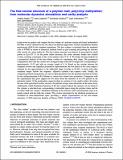Por favor, use este identificador para citar o enlazar a este item:
http://hdl.handle.net/10261/21094COMPARTIR / EXPORTAR:
 SHARE SHARE
 CORE
BASE CORE
BASE
|
|
| Visualizar otros formatos: MARC | Dublin Core | RDF | ORE | MODS | METS | DIDL | DATACITE | |

| Título: | The free-volume structure of a polymer melt, poly(vinyl methylether) from molecular dynamics simulations and cavity analysis |
Autor: | Račko, Dušan; Capponi, Sara; Álvarez González, Fernando CSIC ORCID; Colmenero de León, Juan CSIC ORCID; Bartoš, Josef | Fecha de publicación: | 10-ago-2009 | Editor: | American Institute of Physics | Citación: | Journal of Chemical Physics 131(6): 064903 (2009) | Resumen: | In this work we analyze and compare the free volume of a polymer system poly(vinyl methylether) (PVME) at 300 K obtained by the two direct but different approaches: Positron annihilation lifetime spectroscopy (PALS) and computer simulations. The free volume is calculated from the simulated cells of PVME by means of numerical methods based on grid scanning and probing the structure with a probe of a given radius RP. The free-volume structure was found to be percolated for small probes at RP=0.53 Å. As the probe radius increases, the cavity structure breaks into isolated cavities, reaching a maximum of the cavity number at RP=0.78 Å. We further develop methods for a geometrical analysis of the free-volume cavities by considering their shape. The geometrical computations show that the cavities have elongated shape with side-to-length ratio corresponding to approximately 1:0.55 and with an average length of 6 Å. Based on the overlap between the computed cavities and simplified geometrical representations, the best match of the cavity shape is obtained for the approximation to the ellipsoidal shape (overlap on 84.4%). A match with other examined shapes follows the sequence: ellipsoid>cylinder>bar>sphere>cube. Finally, the computed geometrical parameters are used as input parameters into the quantum-mechanical models for the orthopositronium (o-Ps) lifetime in various free-volume hole geometries. Comparison with the experimental data gives support for two ideas about the existence of an o-Ps particle in the polymeric matrix: (i) the positronium cannot localize in a portion of very small cavities; (ii) and in the case of the percolated cavities, several o-Ps particles occupy some subcavities in the same cavity. Additionally, radial distribution functions of the free volume indicate the existence of two kinds of free volume, a structured one, corresponding to interstitial spaces along the polymer chain, and the so-called “bulk free volume,” distributed randomly in the structure. PALS measurements seem to be mainly related with this bulk free volume. The cavities represented by the idealized geometries are visualized in three-dimensional space providing a unique representation on the free-volume structures. | Descripción: | 10 pages, 6 figures, 2 tables. | Versión del editor: | http://dx.doi.org/10.1063/1.3193727 | URI: | http://hdl.handle.net/10261/21094 | DOI: | 10.1063/1.3193727 | ISSN: | 0021-9606 |
| Aparece en las colecciones: | (CFM) Artículos |
Ficheros en este ítem:
| Fichero | Descripción | Tamaño | Formato | |
|---|---|---|---|---|
| GetPDFServlet.pdf | 1,1 MB | Adobe PDF |  Visualizar/Abrir |
CORE Recommender
SCOPUSTM
Citations
24
checked on 12-abr-2024
WEB OF SCIENCETM
Citations
20
checked on 29-feb-2024
Page view(s)
347
checked on 23-abr-2024
Download(s)
337
checked on 23-abr-2024
Google ScholarTM
Check
Altmetric
Altmetric
NOTA: Los ítems de Digital.CSIC están protegidos por copyright, con todos los derechos reservados, a menos que se indique lo contrario.
